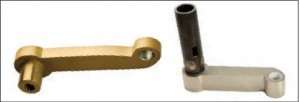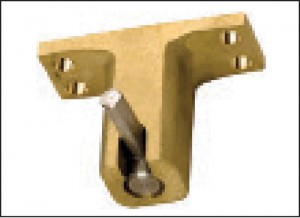Maintaining Balance: The form and function of balanced door systems
Once the system is installed and the torsion bar is adjusted, the gears remain stationary—eliminating any worry about debris that may interfere with the movement. The floor box does not require much space at 13 mm thick, 178 mm (7 in.) from interior to exterior, and 92 mm (3 5/8 in.) wide. The floor box can be installed atop the existing floor, eliminating the need for a floor cut-out. It is the same thickness as most threshold material. However, if a flush look is desired—for example, an interior vestibule entrance—the floor box thickness will be the same as most top-layer floor coverings, such as tile. This allows the floor box to be installed flush with the flooring, while still eliminating the need to cut out any of the structural concrete below.

Semi-automatic hold-open
A spring-loaded attachment, located on the door’s bottom rail, holds the door in the full-open 90-degree position by a foot pin that slides into a hole in the threshold adjacent to the hinge jamb out of the walking area. This means a brick, block, or other type of object to hold the door open is not needed.
Compared to traditional doors
A typical entry door has a fulcrum located on its side, which is attached to the frame with hinges. The result is the user has to pull the entire weight of the assembly to open. Additionally, the weight of the door leaf hangs on the frame, constantly applying force to both the hinge and frame.
A balanced door pivots at two-thirds the door width, distributing the weight and creating a balance allowing the door to easily open. Instead of hinges, a balanced door uses a top and bottom arm that supports the door leaf. Since weight is distributed to the bottom arm, down to the floor plate, and ultimately to the floor itself, stress is transferred away from the frame, eliminating the issues created by conventional hinge-style doors.

While traditional doors have a circular arc projection, the elliptical swing path of a balanced door reduces door leaf projection by one third. In many cities, sidewalk space is valuable. If there is heavy foot traffic, a door opening into the flow of traffic can interrupt the passage of pedestrians. As only two-thirds of a balanced-door leaf project to the exterior of the building, less sidewalk space is taken while the door is open, allowing people to easily pass by.
Typically, entry doors last approximately 10 years with general use. Quality balanced doors are factory made and contain parts that are cast and machined with high-grade materials. For this reason, and because of the physics of their operation, balanced doors survive the test of time, generally lasting many decades (the oldest installations are 80 years and counting).
When to consider balanced door systems
Balanced door systems should be considered in areas where high traffic, excessive abuse and usage, wind and stack pressures, and door size and weight are factors. The balanced design allows for large, heavy, and durable doors to be opened with relative ease. Despite a heavier door leaf, the hardware and inset pivot location enables a fluid range of motion with reduced leaf projection.


Against stack pressure of a building or high winds, balanced doors open and close better than other hinge types. Thanks to the concealed torsion bar closer spring, the door closes after use and remains closed until the next use. In comparison, conventional doors require the user to pull against wind forces (from outside or stack pressures from the interior). A balanced door allows wind pressures to work with the person using the door. As the individual pulls the outer two-thirds of the door against wind and other forces, he or she is assisted on the other third of the door opposite of the fulcrum by the same forces. Wind pressures push in the opposite direction, assisting the user in operating the door. This same principle applies when the door self-closes after use.
Balanced doors can be a great option when customized doors are needed. In some cases, adding ornamentation—such as castings, grilles, panels, and appliqués—adds tremendous weight. Even with this extra weight, a balanced door still allows the user to open the door using less force than that of a swing door. When using additional items, due to the elliptical swing path—two-thirds projecting outward and one-third inward—13 mm (1/2 in.) is the maximum projection off the exterior face of the door (at the hinge side).

Space requirements and considerations
Balanced door sizes vary from 838 to 1219 mm (33 to 48 in.) wide. Two arm (top and bottom) sizes are available to accommodate various widths. The former accommodates doors from 838 to 991 mm (33 to 39 in.) wide. This size provides a door projection of 317.5 mm (12 1/2 in.) while the exterior door projection is 521 to 673 mm (20 1/2 to 26 1/2 in.), depending on the door leaf width.







